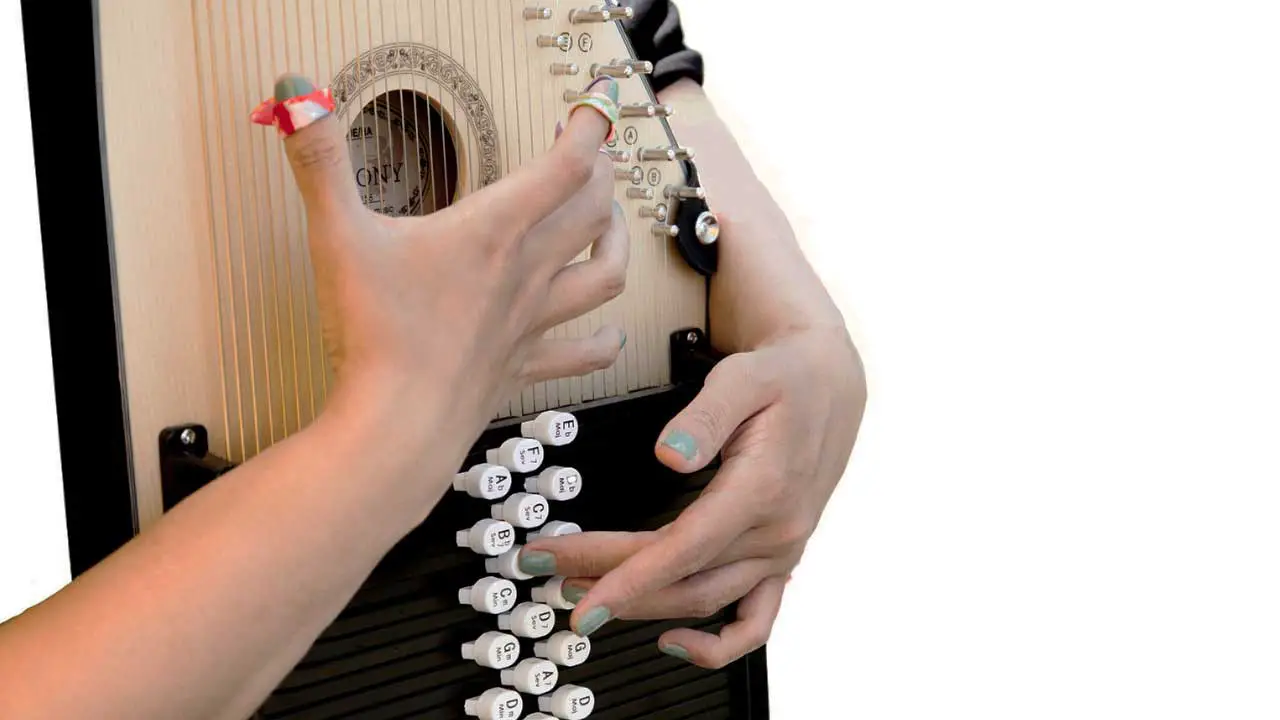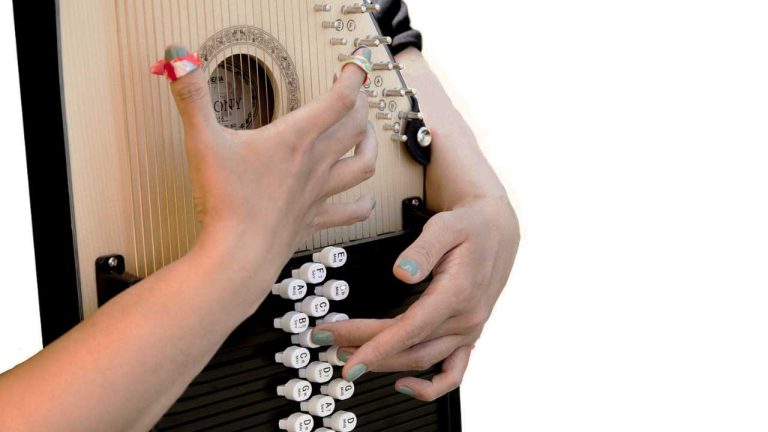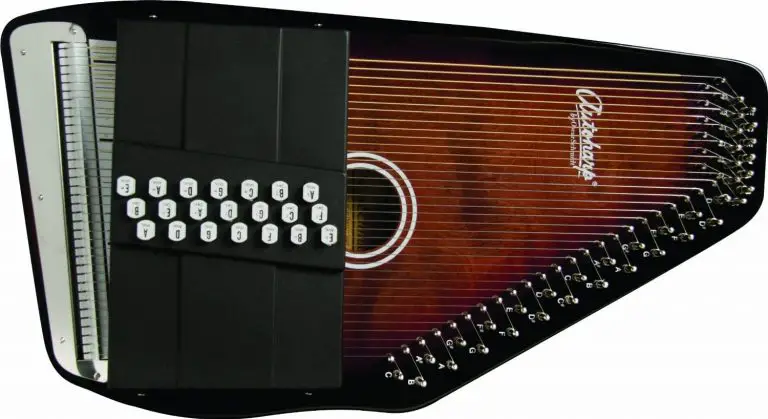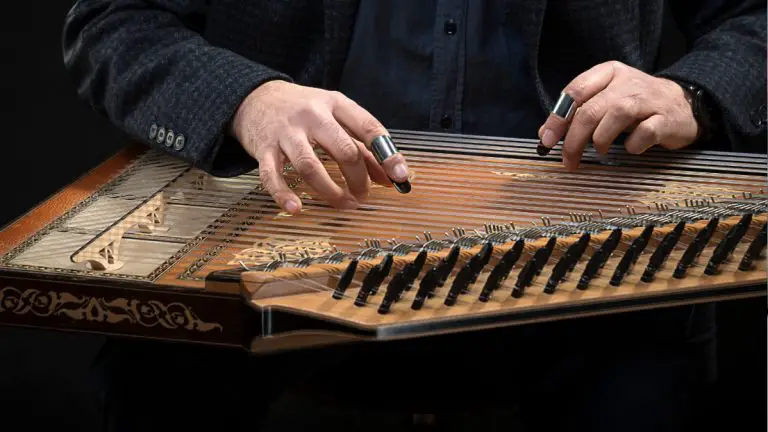How Does the Autoharp Work? – Unveiling Its Melodic Secrets
Folkstrings.com is reader-supported. When you buy through links on our site, we may earn a small commission.
The autoharp is an intriguing string instrument that belongs to the zither family. It simplifies the complex process of playing harmonized music.
It operates on a fairly straightforward principle. Pressing down a button activates a mechanism that dampens all strings except those that form a specific chord. This allows the player to strum and produce harmonious music effortlessly.
This unique system of chord bars and dampers enables even beginners to quickly create music. It also facilitates more complex play styles for advanced musicians.
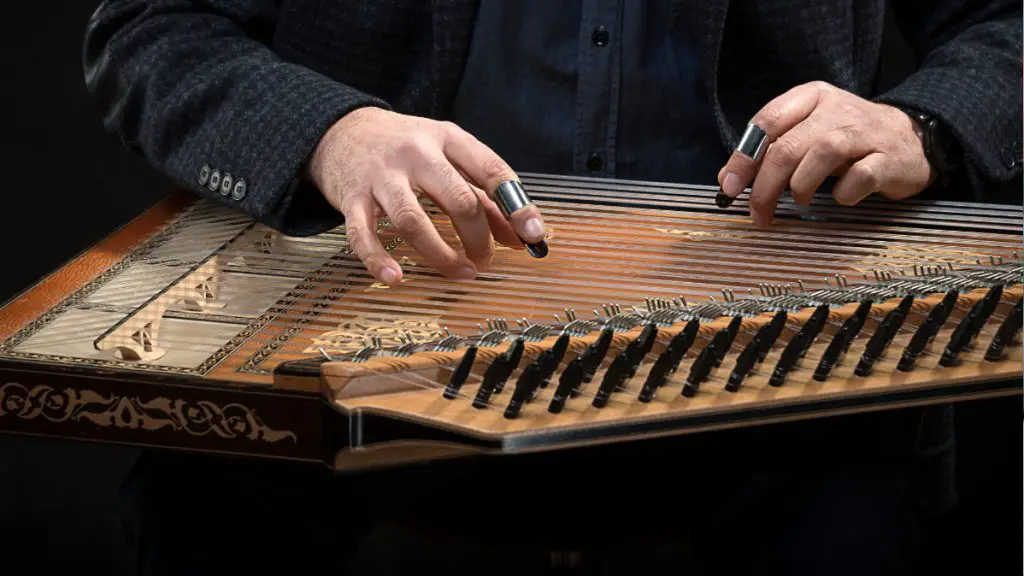
My connection with the autoharp began during a folk music session where its captivating sound immediately caught my attention.
The versatility of the instrument allows it to adapt to a variety of musical styles. It resonates well not only in folk traditions but also in country, rock, and even classroom music education.
Despite its relative simplicity, the instrument demands a level of nuance in playing techniques. These include fingerpicking and strumming patterns, which contribute to its rich and melodic sound.
Key Points
- The autoharp is part of the zither family and makes harmony accessible through a button-activated mechanism.
- Its design supports a range of musical styles, making it a versatile instrument in many settings.
- Playing the autoharp involves distinct techniques that increase its expressive capabilities.
Table of Contents
History and Development
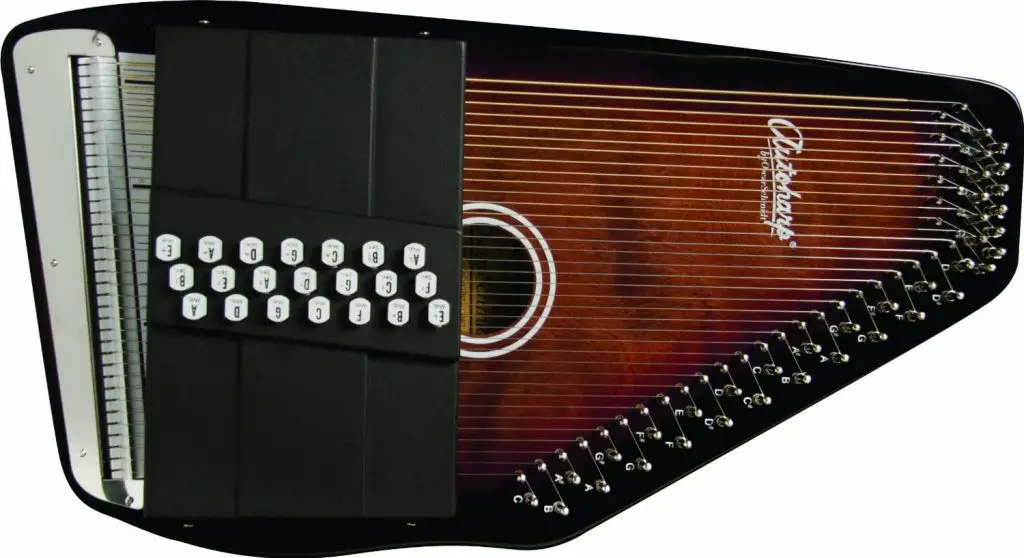
When I explore the history of the autoharp, I find an intricate tale of invention, evolution, and passionate individuals who have left their mark on this unique instrument. It’s a story that begins overseas, takes shape through legal patents, and is defined by key figures whose contributions have shaped the autoharp into what I know it to be today.
Origins of the Autoharp
The autoharp, as an instrument, did not originate in a vacuum. Its roots can be traced back to Germany where a similar instrument known as the volkszither was in use.
The person credited with the creation of what I call the autoharp is Charles F. Zimmermann, a German immigrant and instrument manufacturer based in Philadelphia.
Zimmermann was awarded his first patent in the United States for the autoharp design in the 1880s. He aimed to create an instrument that could be played easily by those without a musical background.
Evolution and Patents
Post Zimmermann’s initial invention, the autoharp underwent several alterations and improvements.
Karl August Gütter, another inventor from Markneukirchen, Germany, took Zimmermann’s concept and modified it to create a more user-friendly version of the instrument.
It was Gütter’s version that more closely resembles the modern autoharp I am familiar with today.
Over the years, numerous patents were filed. These added to the nuances of the autoharp’s construction and mechanics, ensuring the instrument continually evolved to become easier to play and more accessible to a wider audience.
Notable Figures in Autoharp History
While Zimmermann laid the groundwork, there have been many notable figures who have influenced the autoharp’s development.
Among them is Oscar Schmidt, who played a significant role in the commercialization of the autoharp in the early 20th century.
Schmidt managed to avoid Zimmermann’s patents by creating his own version of the autoharp, which he heavily marketed in the United States. His efforts helped cement the autoharp’s place in American music.
Additionally, the trademark ‘Autoharp’ eventually became associated with instruments made by the R. J. Coulter and Oscar Schmidt companies, rather than Zimmermann’s original creation.
Design and Construction

In dissecting the design and construction of an autoharp, I’ll walk you through its key structural elements, varied types, and the materials commonly used to craft these unique instruments.
Structure and Components
The autoharp is a member of the chorded zither family, which traditionally utilizes a series of strings stretched over a resonant soundboard.
Most autoharps feature a pin-block, made of durable wood, to anchor metal tuning pins. These pins allow for precise tension adjustments for each string, essential for accurate tuning.
The heart of the instrument’s easy playability lies in the button-controlled bars.
When pressed, these bars mute all strings except those that form a specific chord, allowing the player to strum full chords with ease.
A bar magnetic pickup is occasionally added, especially in the reverse-strung model, to electronically amplify the sound.
Types of Autoharps
Autoharps can vary in design, with traditional models typically offering 15 or 21 chord bars that correspond to an array of major, minor, and seventh chords.
Over the years, innovative designs have emerged, such as the reverse-strung autoharp which inverts the typical string layout to offer a different playing experience.
Additionally, some modern autoharps include adaptations to accommodate a broader range of musicality and playability, such as fine-tuning systems or built-in electronic pickups for amplification.
Materials Used
- Soundboard: Usually crafted from spruce or cedar for optimal sound resonance.
- Frame and Pin-block: Often constructed from hard woods like maple or cherry to ensure stability and durability.
- Strings: Generally made of steel, these vary in gauge to produce different pitches.
- Buttons and Bars: Commonly formed from durable plastics or wooden materials.
Craftsmanship plays an essential role in the instrument’s quality, with many preferring handcrafted autoharps for their superior sound and individuality.
Laminated construction is sometimes employed for added strength and cost effectiveness. However, solid woods are valued for their resonance and tonal clarity, especially in high-quality instruments.
Playing Techniques

When I approach the autoharp, I focus on the unique blend of simplicity and complexity this instrument offers. My techniques vary depending on the level of mastery I am aiming for, but the joy of creating music remains constant.
Basic Playing Method
The fundamental method of playing an autoharp involves pressing down on the chord bars to select the desired chord while strumming the strings with the other hand.
When I first started, I placed the autoharp on my lap or a table, creating a stable position that made it easier to manipulate the strings and chords. Here’s what I typically do:
- Chord Selection: Press a chord bar to mute the strings not in that chord, leaving the others open to vibrate.
- Strumming: I use my fingers or a pick to strum the strings, which can be done in a downward motion across all strings or by targeting specific strings for a more melodic effect.
Advanced Techniques
As I gained experience, I explored more complex playing techniques that allowed me to create richer sounds and delve into a variety of music genres, particularly folk.
- Finger Picking/Plucking: I sometimes opt to pluck individual strings to play melodies or to integrate more intricate rhythms.
- Muting: Another technique I use involves partially muting certain strings with my fingers to accentuate some notes over others.
- Combination of Techniques: Combining these techniques can lead me to discover my own unique style, whether I’m playing a chromatic autoharp or an electric autoharp.
Maintenance and Tuning Tips
Maintenance ensures my autoharp stays in good condition and tuning it properly keeps the music sounding as it should.
- Regular Cleaning: I make sure to regularly dust the harp and keep it free of debris.
- Tuning: Using an electronic tuner, I tune each string to the correct note. The strings of an autoharp span multiple octaves, so it’s important to be precise.
- String Replacement: I check for any damaged strings and replace them as needed to maintain the quality of sound.
Musical Styles and Influence
I’ve always found the versatility of the autoharp impressive, particularly in how it adapts to various genres and has been showcased by influential musicians. Let’s explore the distinct styles and some standout artists who have left their mark on the music world through this unique instrument.
Genres and Playing Styles
- Folk Music: Folk music fans often praise the autoharp for its simplicity and the ease with which beginners can pick it up. The instrument is well-suited for the narrative quality of American folk music, with its gentle and emotive chordal accompaniment.
- Country: The semi-chromatic nature of the autoharp allows it to flexibly adapt to the soulful melodies of country music, from traditional to contemporary.
- Bluegrass: In bluegrass, the lively strums and finger-picking techniques on an autoharp add a rich, full-bodied sound that complements the quick tempos and harmonies indicative of the genre.
Autoharps can range in quality, but even entry-level instruments are capable of producing a sound that resonates with the warmth and authenticity required by these genres.
Influential Artists and Performances
- Maybelle Carter: My appreciation for the autoharp was magnified by the legendary performances of Maybelle Carter. Her adept use of the autoharp brought it into the limelight, especially on the stage of the Grand Ole Opry.
- American Folk Scene: I’ve observed how the autoharp has been a staple in the United States’ American folk scene. Various artists use its distinct sound to create a connection with their audience.
By blending simplicity with a capacity for intricate musical expressions, the autoharp’s influence spans across various musical styles. It offers a soulful accompaniment that has shaped American music tradition.
Frequently Asked Questions
Before we begin, I want to share some key points that will clarify how the autoharp works. This section will answer some common queries you might have as a beginner or as someone curious about this unique instrument.
What are the basic steps to playing the autoharp for the first time?
When I first approach the autoharp, I make sure it is properly tuned. Then, I hold it comfortably against my body.
By pressing down the chord bars with my left hand, I can easily select chords. I use my right hand to strum the strings adjacent to the chord bars to make music.
What are the distinct sound characteristics of an autoharp?
The autoharp has a rich, full sound thanks to its many strings and the ability to play chords with a single touch of a button. It can produce a sweet, resonant melody that is especially charming in folk and traditional songs.
What techniques are involved in learning to play the autoharp?
I had to learn a few techniques like proper fingerpicking and strumming patterns, delicate string damping, and smooth chord transitions.
As I advanced, I explored more complex techniques to make my playing style more dynamic.
In what ways do the autoharp and zither differ?
The autoharp and zither may appear similar, but they differ in some key aspects. I noticed the autoharp has chord bars that make it easier to play chords, whereas a zither requires me to form chords manually across a larger number of strings.
How often is tuning required for maintaining an autoharp?
Like any stringed instrument, I tune my autoharp often to ensure the best sound quality.
Atmospheric conditions like humidity and temperature can affect tuning stability. So, I check the tuning before every session and adjust when necessary.
What should I expect when using a pick to play the autoharp?
Using a pick allows me to control the volume and crispness of the sound. I find that it helps me produce a clearer, more pronounced tone.
This is especially true when I’m aiming for a brighter sound during performances.
Author Profile
-
Daniel Johnstone is an English writer with a love for stringed instruments from around the world.
He shares his love for these instruments through his writing for folkstrings.com, a website dedicated to all things related to folk string music.
Daniel's passion for music started at a young age, and he has since become an accomplished musician, playing guitar, cavaco, and recently, the harp.
His dedication to learning and sharing his knowledge of stringed instruments is evident in his insightful and engaging blog posts. Whether you're a seasoned musician or a beginner, Daniel's writing is sure to inspire and entertain you.
When he's not playing music or writing, you can find Daniel exploring new instruments and seeking out new sounds to share with his readers.
Latest entries
 AutoharpApril 4, 2024What Is the Autoharp Made Of: Exploring Its Materials and Craftsmanship
AutoharpApril 4, 2024What Is the Autoharp Made Of: Exploring Its Materials and Craftsmanship AutoharpApril 4, 2024Is Autoharp Easy to Play? Unveiling the Truth for Beginners
AutoharpApril 4, 2024Is Autoharp Easy to Play? Unveiling the Truth for Beginners AutoharpApril 4, 2024What Is an Autoharp Worth? Your Guide to Pricing and Value
AutoharpApril 4, 2024What Is an Autoharp Worth? Your Guide to Pricing and Value AutoharpApril 4, 2024Are Autoharp and Zither the Same Thing? Unraveling String Instrument Myths
AutoharpApril 4, 2024Are Autoharp and Zither the Same Thing? Unraveling String Instrument Myths
Affiliates:
This post may contain affiliate links that at no additional cost to you, the site may earn a small commission. We only recommend products we would use ourselves and all opinions expressed on this site are our own.
Accuracy Advice:
While we strive to provide up-to-date and accurate information, the content in this article may not reflect the most current research or medical guidelines. We encourage readers to do further research and consult with professionals for more personalized advice.
Our Recommendations:
The products and services mentioned in any of our articles are recommended based on our independent research and personal experience. We are not sponsored by any company. We aim to suggest products and services we believe are of high quality and could be beneficial to our readers.

